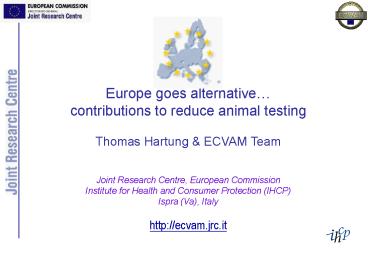Europe goes alternative contributions to reduce animal testing - PowerPoint PPT Presentation
1 / 21
Title:
Europe goes alternative contributions to reduce animal testing
Description:
Animal welfare directive 1986 (86/609/EEC) Established 1991, 61 staff members ... Forerunner Episkin opens the avenue for others to follow ... – PowerPoint PPT presentation
Number of Views:38
Avg rating:3.0/5.0
Title: Europe goes alternative contributions to reduce animal testing
1
Europe goes alternativecontributions to reduce
animal testing Thomas Hartung ECVAM
Team Joint Research Centre, European
Commission Institute for Health and Consumer
Protection (IHCP) Ispra (Va), Italy http//ecvam.
jrc.it
2
ECVAM
- Animal welfare directive 1986 (86/609/EEC)
- Established 1991, 61 staff members
- 16 alternative methods validated until 2002
- Business plan and reorganization 2003 responding
to7th amendment of the cosmetic directive
2003emerging REACH legislation 2007 - 9 methods validated 2006
- 5 methods expected April 27th 2007
- Focus FP7 more drug, vaccine, food plus
CORRELATE
3
Purposes of animal experiments in 2002 (EU-15,
statistics DG Environment)
- Total number 10,700,000 100
- Safety evaluations 1,060,000 10
- Agricultural chemicals 123,000 1
- Industrial chemicals 136,000 1
- Cosmetics 2,700 0.025
4
Often forgotten there was good reason to
introduce animal experiments, e.g. Draize eye test
5
3R Success stories
- OECD acceptance of ECVAM validated methods
- 1999-2001- Refine Painless test for skin
sensitisation - Reduce Animal numbers for
acute tox. from 45 to 8 (REACH 1.1 million
saved) - 2004 Replace - phototoxicity- skin corrosion
6
Cosmetics industry and the 7th amendment
- EU 2.000 companies, 60 billion turnover
- EU 5.000 new products per year, 25 turnover
with products released within last 6 months - Marketing ban if testing finished products or not
using ECVAM-validated methods since 2003 - Phasing out ingredient testing with test and
marketing bans in 2009 and 2013 - Critical need for alternatives
7
Chemical industry and REACH
- EU 27.000 companies (96 SME), 590 billion
turnover 33 of world market, 1,7 million
employees - EU occupational skin disease cost 3 million work
days per year, i.e. about 600 million - 86 of toxicological data on old chemicals are
lacking - REACH will assess 30.000 chemicals marketed gt1
ton/year - Expected 180.000 preregistrations 2009, 70 of
testing 2011-2017 - Alternatives increase test through-put and reduce
costs and animals
8
Validated 2006 Mutagenicity
- Micronucleus test improves in vitro assessment
for mutagenicity / genotoxicity - First validation based only on a compilation of
existing data, no new study - Completed in two years, within one month
included in REACH legislation - Currently considered by OECD and ICH
(International Conference on Harmonisation) - Accelerated validation
9
Validated 2006 Acute Ecotoxicology
- Test strategy developed and validated by ECVAM
and European Chemical Bureau within two years - Saves 60 of fish
- Implemented for REACH saving 170.000 fish and 23
million testing costs - Submitted to OECD, EMEA etc.
10
Expected validity Skin irritation
- Rabbit test for drugs, chemicals and cosmetics
introduced 60 years ago - Validation study 2003-2006 of three models with
9 labs (2 U.S.), 58 test chemicals - Best model (Episkin), optimized in an FP4 DG RTD
contract, represents a full replacement
11
Artificial human skin
- Biotechnology product originally to treat burn
patients - 5 European and 1 American producer
- Forerunner Episkin opens the avenue for others
to follow - 2009 deadline of cosmetics directive, 10.000
REACH substances
Skin
Reconstructed epidermis EPISKIN
12
Expected validity Eye irritation
- Retrospective evaluation with U.S. ICCVAM
- 4 tests analyzed, 2 qualify for the detection of
severe eye irritants confirming an ECVAM analysis
of 2003 - 8 other assays and the suitability for mild
irritants currently under evaluation - Intense collaboration with COLIPA
- REACH 10.000 substancescritical for cosmetics
2009
13
Expected validity Skin allergy
- OECD accepted, validated alternative method
(Local Lymphnode Assay) is the reference method
for 30.000 REACH chemicals - Test strategy to test only highest dose results
in 50 less animals with lt1 of substances missed - Concept by ECVAM task force 2006
- Foreseen already in REACH test strategy (saves
240 thousand mice)
14
Test strategy development for REACH
- Key contribution to REACH implementation process
- CEFIC management, strong regulator and industry
involvement, gt200 experts - ECVAM as coordinator for Commission
- About 2.000 pages ready May 2007
- Many methods under validation already foreseen
15
Estimated test animal need for the different
endpoints
16
Computational Toxicology
In silico methods
PHYSICAL PROPERTIES
TOXICITY
- SARs Structure-Activity Relationships
- AND
- QSARs Quantitative Structure Activity
Relationships - are theoretical models that relate the
structure of chemicals to their properties
CHEMICAL STRUCTURE
ENVIRONMENTAL DISTRIBUTION
BIOKINETICS
17
Computational Toxicology and Environmental Risk
Modelling (European Chemicals Bureau)
Promoting the availability for regulatory use of
valid computer-based methods
- ACTIVITIES
- QSAR software tools for regulatory purposes
(downloadable or accessible from the ECB website
http//ecb.jrc.it/qsar/). - Case studies on QSAR validation and guidance
document on QSAR validation. - REACH guidance on grouping of chemicals and
regulatory use of QSARs.
18
State of the play
19
Current Activities Prospects
- Online availability since 29th October 2006
- Protocols for alternative methods (cook book)
- Continuously extended data collections for all
toxicological areas - Extension to computational toxicology
- ECVAM website http//ecvam.jrc.it
http//ecvam-dbalm.jrc.it
20
Europe goes alternative 1st Conference,
Brussels, 7th Nov 2005 2nd Conference, Brussels,
18th Dec 20063rd Conference, planned 5th Nov 2007
- Hosted by Commissioners G. Verheugen (DG ENTR)
and J. Potocnik (DG JRC / DG RTD) - European Partnership (7 trade associations,
27 companies) - Action programme
21
Thank you!

